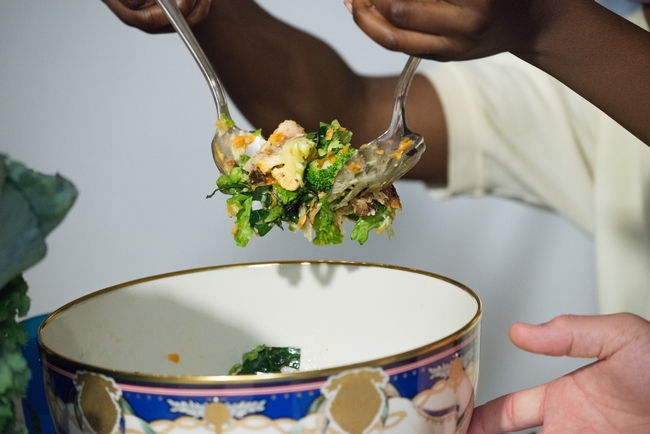- Author: Pamela Kan-Rice
Helping people attain financial security and healthy, active lives has been a career passion for Patti Wooten Swanson, UC Cooperative Extension nutrition, family and consumer sciences advisor for San Diego County. Wooten Swanson, who joined UC Agriculture and Natural Resources in 2001, retired July 1, 2019, from a career of research and outreach focused on family financial management and nutrition education to help San Diego County residents improve their lives.
Melinda Opperman has worked with Wooten Swanson on several campaigns promoting financial wellness that received proclamations from the San Diego City Council, mayor and board of supervisors.
“She was instrumental in improving people's financial lives and promoting the common purpose of financial wellness. Her work was critical,” said Opperman, executive vice president of Springboard Nonprofit Consumer Credit Management in National City.
In 2005, Wooten Swanson launched the annual San Diego Saves, part of the America Saves campaign, to encourage San Diegans to improve their financial security.
“The basic message is to encourage people to build wealth through systematic savings over an extended time, with an emphasis on saving and paying down debt,” Wooten Swanson said at the time. She persuaded consumer advocates, credit unions, banks and other local businesses to offer savers' clubs and money-management workshops. As part of San Diego Saves, several financial institutions offered savings accounts that could be opened with as little as $5 and no fees for 12 months.
In her research, the Cooperative Extension advisor found that people were more successful at building their savings if they wrote down a goal, such as buying a car. Wooten Swanson also encouraged saving through payroll or checking account deductions, saying, “You won't miss what you can't see.”
In her blog Small Steps To Health And Wealth, Wooten Swanson provided practical tips for consumers to eat healthfully, avoid foodborne illness and save money.
She also authored UC ANR's Financial Caregiving Series for adult children of aging parents. Recently Wooten Swanson co-chaired the Money Talks workgroup that developed “Living on Your Own” guidebooks, currently in production. The guidebooks outline living expenses low-income youth and young adults should consider before moving to their own apartments. As UC Cooperative Extension advisor emeritus, she plans to promote the Living on My Own program at professional society meetings.
An active community member, Wooten Swanson served on the San Diego County Food System Initiative leadership team and as a research partner with a volunteer gleaning program that provides fresh produce to food insecure families. She also trained social workers to give their clients just-in-time money management information.
Her contributions to the field of family and consumer sciences were recognized with the 2018 Leader Award from the American Association of Family and Consumer Sciences' California affiliate. The National Extension Association of Family and Consumer Sciences honored Wooten Swanson with its 2018 Excellence in MultiState Collaboration Award (Eastern Region) for her contributions to a NIFA Extension Project, and its 2017 Continued Excellence Award for her leadership and promotion of the professional development of others.
Wooten Swanson earned her Ph.D. in consumer science at Texas Woman's University, an M.Ed. in vocational education at North Texas State University and B.S. in home economics at Texas Christian University.
After a busy 44-year career in education, Wooten Swanson is enjoying spending more time with her husband, Jerry, at their home in San Diego and traveling. Once Quicken, her English springer spaniel, gets certified as a pet therapy dog, she plans to volunteer to cheer patients at Scripps Mercy Hospital.
- Author: Norma De la Vega
- Adapted into English by: Jeannette E. Warnert
The end-of-year holidays are a perfect time to enjoy family, gifts and food. It's time to laugh, relax, cook and eat the most delicious meals of the year.
Unfortunately, it can also be a time when excess can put your health and finances at risk, leaving you to begin the New Year with debt, stress and anxiety.
Experts with UC Cooperative Extension have practical advice to make the festivities joyful and worry-free. They also provide some simple guidelines to select toys for children with maximum fun and minimum heartache.
Don't go into debt
Shopping is a temptation all year, but during the holidays even conservative shoppers can be seduced into spending too much. In the United States, the average shopper will spend $885 on gifts, according to Gallup.com. For that spending, UCCE experts recommend shoppers avoid making purchases on credit.
Patti Wooten Swanson, UCCE nutrition, family and consumer sciences advisor in San Diego County, believes using a credit cards encourages over spending. Before you know it, the debt will begin to acquire interest, the interest continues to grow, and the purchases become substantially more expensive.
She suggests shoppers establish a budget, think of the people you would like to give gifts, and determine the amount of cash available for each of them before heading to the store.
“Organizing the expenses is very important for people at all income levels to learn to manage money, reach financial security and use their economic resources to acquire what is really important for you and your children,” Wooten Swanson said.
Following are recommendations for using a credit card:
- Don't use a credit card to make a purchase if you don't have the funds to pay it off at that moment.
- Understand that the actual cost of interest can vary greatly, from zero percent for a limited time up to 30 percent. Pay all charges at the end of the month to avoid paying interest.
- Avoid paying only the minimum payment on your credit card, as creditors may then consider you “high risk” and increase your interest rate.
- An advantage of paying with a credit card is the security of not having to take cash with you shopping.
Remember, spreading holiday cheer doesn't require spending a lot of money. There are also treasured gifts, such as those that are homemade, that will persist in the recipient's memory because they come from the heart.
Eat everything, but in moderation
The holidays hail the arrival of many rich dishes, such as tamales, roasted meats and an array of chocolates, cookies and desserts. Many of these foods require a great deal of preparation and are only available at this time of year, increasing the temptation to eat them. But, they often contain a significant amount of salt, sugar and fat.
“Everybody knows we eat because we have to nourish our bodies, but we also eat for pleasure, to socialize or because we enjoy the flavors of the foods,” said Lorrene Ritchie, director of the UC Agriculture and Natural Resources' Nutrition Policy Institute. “Sometimes what we like eating isn't the most healthy, and it's important to know that you don't have to feel guilty and renounce all foods that are unhealthy. Just be sure that most of the time you and your children opt for healthy foods.”
Following are a few suggestions from UC ANR experts can make the holiday eating and playing healthier and safer.
Drink water
During the festivities, we can allow ourselves to enjoy a sugary drink now and then, but always drink water to quench thirst.
“To work off one can of soda, you'll have to walk a few hours. Calories don't burn off very rapidly with physical activity,” Ritchie said.
Salads at your parties
Salads are very healthy, and the more colorful, the better. Each vegetable of a different color contains different nutrients.
“Latinos love fruit. I believe we eat enough fruits,” said Margarita Ramirez Schwartz, UC Cooperative Extension nutrition educator in San Diego County. “But we don't consume as much vegetables, and above all, raw salads.”
At your parties, always serve salads. If you don't have time for salad preparation, opt for convenience products like packaged vegetables and greens that are pre-washed, pre-cut and ready to serve.
Dance
A family dance creates timeless memories. There is no grandparent that can decline when a granddaughter wants to dance. Among Latinos, dancing is part of the culture. Be it salsa, samba, huapango or merengue, any rhythm will help you stop eating, have fun and improve your health.
“The key is to realize that exercise is as important for your health as eating and sleeping,” Ramirez-Schwarz said. “We all want to live for many years, and spend those years enjoying good health. No one likes to be sick and physical activity is part of illness prevention.”
Toys
The joy of Christmas and Epiphany for children often takes the form of new toys, which entertain and spark imagination and creativity. Parents want their children to be happy and have the opportunity to learn by playing with safe toys. Alas, it doesn't always work out this way.
In 2016, there were 240,000 injuries related to toys, according to the Consumer Product Safety Commission. Toys usually appear harmless, but children with injuries caused by toys arrive at hospitals every year. WATCH (World Against Toys Causing Harm, Inc.) is a non-profit organization that monitors toy safety and compiles a list of harmful toys. For example, the leash on a wooden dog can cause strangulation. The lighted eyes that detach easily from a stuffed unicorn can choke a youngster. A toy rifle that shoots plastic disks can hit another child in the eye.
UC ANR experts recommend that you choose toys that will hold a child's interest, taking into account the child's age, fine motor skills and preferences. A toy that is too advanced or too simple could be used in the wrong manner and cause accidents. Think big when choosing toys. Each small piece must be larger than the child's mouth to prevent harm.
- Carefully examine the toys made of painted metal. There are some made overseas that can contain high levels of lead.
- Make sure the toy doesn't have small parts on which a child can choke or that can put younger children in the household at risk.
- Avoid toys that are old and used because they may not comply with current security rules or they may be worn out, break easily and be a danger to children.
- Look for toys with a solid structure. You do not want to give a toy to children that can break easily.
- To prevent cuts, check to be sure the toy doesn't have sharp points or edges.
- Avoid toys that make a lot of noise that could damage the child's hearing.
- Be sure activity books and art supplies are nontoxic.
- Give the toy with batteries, if needed, so that the children won't be frustrated when they receive the gift.
Finally, remember that there is no better gift to children than your time. The toy will be forgotten shortly, but the time that children spend with their families will create life-long memories.
Read the Spanish version of this story.
- Author: Jeannette E. Warnert
For the 11th year in a row, the most popular item on holiday wish lists is gift cards. According to a 2017 National Retail Federation Survey, 61 percent of respondents wished for gift cards, while 55 percent listed clothing and accessories and 39 percent would like books, music or movies.
“In the past, gift cards may not have seemed like a very thoughtful gesture,” said Patti Wooten Swanson, consumer sciences advisor with UC Cooperative Extension in San Diego County. “But today, it's what people want.”
Wooten Swanson has a Ph.D. in consumer science from Texas Women's University in Denton, Texas. She is the author of a seven-part series of financial caregiving publications and is co-chair of the UC Agriculture and Natural Resources Money Talks workgroup, which created a Money Talks website that helps teens and young adults learn to manage their finances.
Gift cards are subject to several consumer protection laws. The federal government mandates that retail gift cards (for a specific merchant or company) and bank-issued gift cards are valid for five years from date of purchase. In California, state law stipulates that most gift cards cannot expire or charge a service fee.
A survey by Consumer Reports found that 10 percent of gift card value typically goes unused. The magazine suggests cash or a check are great alternatives, but Wooten Swanson says she still sometimes opts for gift cards.
“Cash can tend to be used for everyday things,” Wooten Swanson said. “If I want my dad to enjoy a meal at his favorite restaurant, I would give a gift card for the specific restaurant.”
Wooten Swanson offers the following suggestions for ensuring successful gift card experiences:
- If you receive a gift card, use it as quickly as possible. If the retailer goes out of business, the card will have no value. “Also, it's easy to misplace or forget about the card,” Wooten Swanson said.
- Consumers' first choice when selecting gift cards should be those offered by specific retail stores (and their affiliates) or restaurants, Wooten Swanson recommends. “Generally, there are no fees for purchasing them either at the retail outlet, online or at a gift card kiosk in the grocery store,” she said. “The card is valid for at least five years and, by law, no inactivity fees can be charged during the first 12 months.”
- Before buying the gift card, Wooten Swanson suggests looking carefully at the back to be sure that the hidden card number that is usually underneath scratch-off ink has not been exposed. “To steal the value on cards, thieves can copy down the hidden code number at the store. After the card is purchased and funded, the thief can use the code for online purchases, making the card worthless for the person who receives the gift,” she said.
- Always include the store receipt in the gift along with the card. If the gift card is lost or stolen, the recipient can call the company to see if it can be replaced.
- Only purchase gift cards from sources you know are reputable. Some websites allow consumers to buy gift cards at a discount and sell unwanted gift cards at an amount below the face value. “You want to be dealing with a known company to be sure you're getting the real thing,” Wooten Swanson said. She recommends consumers interested in discounted gift cards instead visit big box retailers like Costco or Sams Club, where packets of gift cards are available at a discount.
- Carefully read the conditions attached to bank or credit card company gift cards. They can be used almost anywhere the recipient would like to spend the funds, but most charge a fee to purchase the card and, after 12 months of inactivity, can charge a monthly fee by reducing the balance on the card. “This year many restaurants and retailers are reward those who buy the card with a BOGO bonus. The bonus gift cards obtained often do have an expiration date,” Wooten Swanson said. “Some may not be redeemable immediately.”
- Author: Patti C. Wooten Swanson

While working on this story, I discovered these ducks are on the U.S. Public Interest Research Group's list of 24 potentially hazardous toys. Why? Laboratory tests revealed high levels of a dangerous toxic chemical in the ducks.
The Trouble in Toyland 2014 report released this month warns shoppers that there are dangerous and toxic toys on store shelves this holiday season. The study found toys that you may want to avoid, that…
- are made of materials containing toxic chemicals such as lead
- have small parts that could choke a child if swallowed
- contain powerful magnets that if swallowed could cause intestinal injuries
- make noises loud enough to damage hearing.
So, how can you choose toys that are safe for your child (or nieces, etc.)? One way is to pick age-appropriate toys.
Many manufacturers label toys for age appropriateness. The guidelines factor in a child's developmental stage and the safety issues relevant for the child's age. That means that if you buy a toy labeled as appropriate for ages 4-5, for your “very advanced” 2 ½ year old daughter, you may be exposing her to safety risks.
In deciding what to buy, consider these guidelines from a fellow Cooperative Extension human development expert at Cornell University:
Children under 3: The biggest threat is toys with small parts that could choke them. Avoid marbles, magnets, and games with balls that are less than 1 3/4 inches in diameter. For example, when buying toys such as stuffed animals check to be sure eyes, noses, and other parts are attached securely. Otherwise a part might come lose and be dangerous if swallowed. (Follow this guideline for an older child who still mouths his toys.)
Children 3 to 5: Toys with straps or cords that fit around the neck, such as a toy guitar, is risky because a child could get the cord wrapped around her throat and be strangled. Avoid such toys until the child is older. Or to be safe, cut off cords, strings or straps until the he is older. Avoid toys that are made of thin plastic that can break into pieces or become jagged. Take the batteries out of loud toys or cover speakers with tape.
Children 6 to 12: Avoid toys with sharp or pointed edges, as well any that might easily break into pieces with sharp edges. The Consumer Product Safety Commission (CPSC) recommends NOT buying electric toys with heating elements for children under 8 years old. It advises anyone buying bikes, scooters, skateboards or inline skates to also buy protective gear such as a helmet, kneepads, elbow pads, and wrist guards.
Children and Teens:
- Magnets: Although the risk scenarios differ by age group, the danger is the same. When two or more magnets are swallowed, they can attract one another internally, resulting in serious injuries, such as small holes in the stomach and intestines, intestinal blockage, blood poisoning and even death. When a magnet has to be removed surgically, it often requires the repair of the child's damaged stomach and intestines.
- Toy Guns: Whether or not to buy toy guns is an individual matter. The University of Michigan Health System and recent events suggest toy guns should not look like real guns, and they should be brightly colored in order to be instantly recognizable as toys.
For more information, see Tips for Buying Safe Toys.
Patti Wooten Swanson, Ph.D., is a University of California Cooperative Extension nutrition, family and consumer science advisor in San Diego County.









